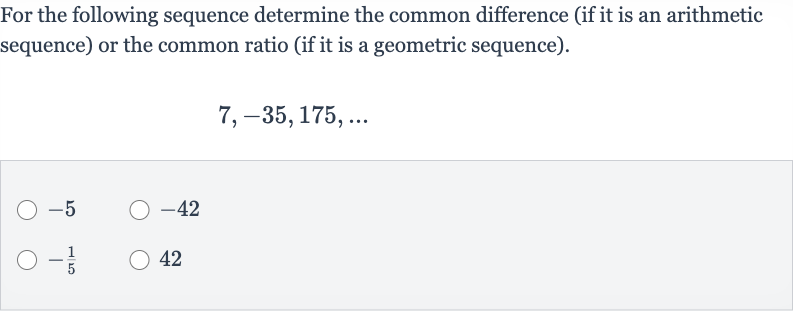Full solution
Q. For the following sequence determine the common difference (if it is an arithmetic sequence) or the common ratio (if it is a geometric sequence).
- Check Common Difference: To determine whether the sequence is arithmetic or geometric, we need to examine the relationship between consecutive terms.Let's first check if there is a common difference by subtracting the second term from the first term and the third term from the second term.Common difference between the first and second term:
- Calculate Common Difference: Perform the subtraction to find the common difference between the first and second term.
- Check Common Ratio: Now, let's find the common difference between the second and third term.
- Calculate Common Ratio: Perform the subtraction to find the common difference between the second and third term.
- Sequence Type Determination: Since the common difference between the first and second term is not the same as the common difference between the second and third term, the sequence is not arithmetic.Now, let's check if there is a common ratio by dividing the second term by the first term and the third term by the second term.Common ratio between the first and second term:
- Sequence Type Determination: Since the common difference between the first and second term is not the same as the common difference between the second and third term, the sequence is not arithmetic.Now, let's check if there is a common ratio by dividing the second term by the first term and the third term by the second term.Common ratio between the first and second term: Perform the division to find the common ratio between the first and second term.
- Sequence Type Determination: Since the common difference between the first and second term is not the same as the common difference between the second and third term, the sequence is not arithmetic.Now, let's check if there is a common ratio by dividing the second term by the first term and the third term by the second term.Common ratio between the first and second term: Perform the division to find the common ratio between the first and second term. Now, let's find the common ratio between the second and third term.
- Sequence Type Determination: Since the common difference between the first and second term is not the same as the common difference between the second and third term, the sequence is not arithmetic.Now, let's check if there is a common ratio by dividing the second term by the first term and the third term by the second term.Common ratio between the first and second term: Perform the division to find the common ratio between the first and second term.Now, let's find the common ratio between the second and third term.Perform the division to find the common ratio between the second and third term.
- Sequence Type Determination: Since the common difference between the first and second term is not the same as the common difference between the second and third term, the sequence is not arithmetic.Now, let's check if there is a common ratio by dividing the second term by the first term and the third term by the second term.Common ratio between the first and second term: Perform the division to find the common ratio between the first and second term. Now, let's find the common ratio between the second and third term. Perform the division to find the common ratio between the second and third term. Since the common ratio between the first and second term is the same as the common ratio between the second and third term, the sequence is geometric with a common ratio of .

